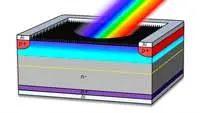Electronics News
Archive : 14 November 2016 год
 A research team at Aalto University in Finland, led by Professor Hele Savin, says it has developed a light detector that can capture more than 96% of the photons covering visible, ultraviolet and infrared wavelengths.
A research team at Aalto University in Finland, led by Professor Hele Savin, says it has developed a light detector that can capture more than 96% of the photons covering visible, ultraviolet and infrared wavelengths.
“Present day light detectors suffer from severe reflection losses as [their] antireflection coatings are limited to specific wavelengths and a fixed angle of incidence. Our detector captures light without such limitations by taking advantage of a nanostructured surface,” said Prof Savin. He added the detector’s low incident angle is especially useful in scintillating x-ray sensors.
“We also addressed electrical losses in traditional sensors that use semiconductor pn-junctions for light collection. Our detector does not need any dopants to collect light; instead, we use an inversion layer generated by atomic layer deposited thin film.”
The work derives from the team’s earlier research on nanostructured solar cells and the nanostructure used in the light detector is similar to that used by the team to create black silicon solar cells with record efficiencies.
Prototype detectors are being tested in medical and safety related imaging applications related to medicine and safety, but the team is seeking new applications for its invention, especially those in the ultraviolet and infrared regions that would benefit from better spectral response.
Author
Graham Pitcher
Source: www.newelectronics.co.uk
 Xilinx has unveiled a FPGA-powered reconfigurable acceleration stack that includes libraries, framework integrations, developer boards, and OpenStack support.
Xilinx has unveiled a FPGA-powered reconfigurable acceleration stack that includes libraries, framework integrations, developer boards, and OpenStack support.
According to the company it will provide the fastest path to realize 40x better compute efficiency with Xilinx FPGAs when compared to x86 server CPUs and up to six times the compute efficiency over competitive FPGAs.
Using dynamic reconfiguration, Xilinx enables silicon optimisation for the broadest set of performance-demanding workloads including machine learning, data analytics, and video transcoding. These workload optimisations can be done in milliseconds by swapping in the most optimal design bitstream.
At present Xilinx FPGAs enable hyperscale data centers to achieve 2-6x the compute efficiency in machine learning inference because DSP architectural advantages for limited precision data types, superior on-chip memory resources, and greater than one year technology lead over FPGA competition.
The Xilinx Reconfigurable Acceleration Stack includes math libraries designed for cloud computing workloads, application libraries integrated with major frameworks, such as Caffe for machine learning, a PCIe-based development board and reference design for high density servers, and an OpenStack support package making Xilinx FPGA-based accelerators easy to provision and manage.
“The new stack will help to accelerates mainstream adoption of our FPGAs in hyperscale data centres,” said Nazeem Noordeen, corporate vice president, IP Solutions at Xilinx. “It delivers the fastest path to realize 2-6x the compute efficiency over FPGA competition.”
Author
Neil Tyler
Source: www.newelectronics.co.uk
 Researchers from The University of Manchester claim to have taken a significant step towards creating quantum computers. Its work is said to show that large molecules made of nickel and chromium could store and process information in the same way as bytes are used in digital computers.
Researchers from The University of Manchester claim to have taken a significant step towards creating quantum computers. Its work is said to show that large molecules made of nickel and chromium could store and process information in the same way as bytes are used in digital computers.
In a paper published in the science journal Chem, the team claims it is possible to use supramolecular chemistry to connect qubits. This approach would generate several kinds of stable qubits that could be connected together into structures called ‘two qubit gates’.
“We have shown that the chemistry is achievable for bringing together two-qubit gates and that the gates can be assembled,” explained inorganic chemist Professor Richard Winpenny. “The next step is to show that they work.”
Prof Winpenny’s team has addressed this problem through algorithmic designs, in which large molecules are combined to to create two qubits and a bridge between the units – a ‘quantum gate’.
Studies are said to show that quantum information is stored in the individual qubits for long enough to allow the information to be manipulated – the so called coherence time.
Prof Winpenny added: “The real problem seems to be whether we could put these qubits together at all. But we showed that connecting these individual qubits doesn’t change the coherence times, so that part of the problem is solvable.”
Author
Graham Pitcher
Source: www.newelectronics.co.uk
